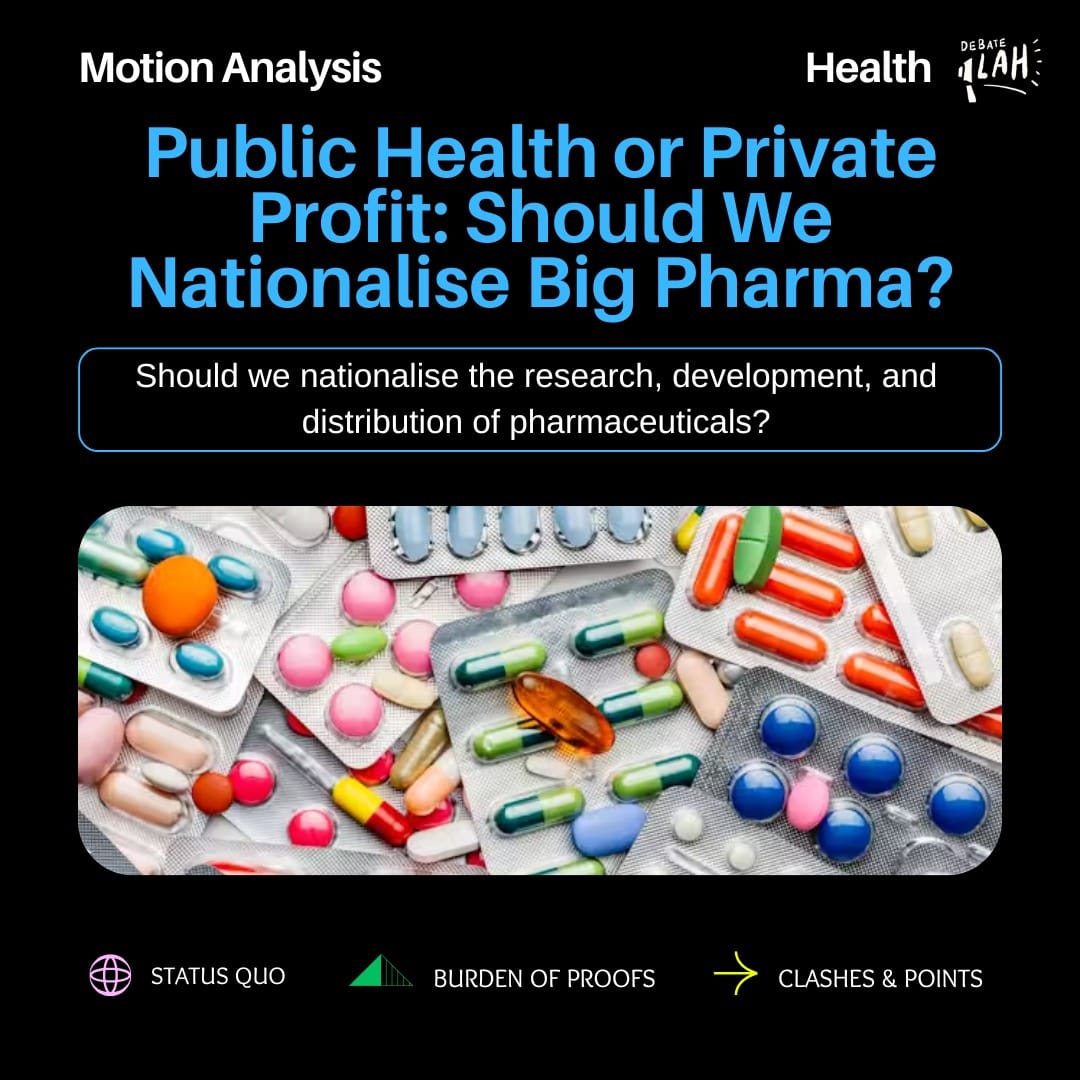Big Pharma
As technology in medicine advances through the years, some individuals and companies turn the opportunity to heal the sick into a cash cow. From monopolising drugs to blocking cheaper generics and biosimilars, Big Pharma has been under the scrutiny of the public for overcharging patients who may desperately need medical treatment. Some call for pharmaceuticals to be managed by the government, trusting that the government would make positive changes for the benefit of its citizens. Some, however, oppose shifting the responsibilities of drug creation to a public sector system as they believe the government is unable to manage pharmaceuticals well as compared to the many medical entities in present.
With reasonable opinions from both sides of the house, let us take a deep dive into the motion:
This house will nationalise the research, development, and distribution of pharmaceuticals
This motion prompts us to think about potential solutions to the inaccessibility of public health. Let us know which side you're on!
Status quo: (Lots of) Money can buy health
From the American healthcare system being infamous for charging its patients exasperating figures for medical bills, to the poor who suffer in their ailments due to their inability to afford treatment, to even the Average Joe's finances burdened from purchasing pharmaceuticals for ill loved ones, Big Pharma undoubtedly needs big changes. However, is nationalising pharmaceuticals the way to go or are there better solutions we can impose on the status quo?
Proponents argue that once the federal government owns medical companies, the brightest talents of the country would flock to contribute to the medical sector, as seen with nationalised space agencies like NASA. Seasoned professionals and young medics alike are welcome to work in the nationalised medical industry. Besides that, proponents promote transparency as they would publicise research projects the nationalised medical industry is progressing on.
Opponents say that they can make medicine accessible and affordable on their side by regulating against monopolistic practices like price gouging and misleading information. Even with these regulations, medical entities remain profitable as the profit they make in the present is excessive. Additionally, they would subsidise companies to produce unprofitable drugs like treatments for rare diseases, or diseases that afflict the poor. Measures such as means-tested subsidies and universal healthcare insurance will be taken to ensure healthcare remains affordable.
#1 Accessibility
Proponents claim that private pharma companies are problematic as they face little competition from firms that operate in different fields, even if there are multiple firms in the industry. There is a first-mover advantage in the pharma industry where once a medical entity establishes a drug, patients flock to it and it is more difficult for future firms to come in. This is why insulin is almost exclusively produced by Novo in the States and epinephrine is monopolised by EpiPen. Private corporations have no incentive to research drugs that won’t be profitable because they want to get as much money as possible.
On the proposition side, different segments of drug research can share technology between them, like how research for one disease, like STEM cells, can be cross-applied to cancer, whereas in the opposition’s world that would be two different firms. Proponents allow technology sharing that improves the efficiency of development. Also, the government has a large voter base that cares about people, such as terminal patients. The government cares about people’s emotions more than companies do. For groups like poor people, their political power exceeds their economic power; they might not have enough money to buy drugs or to pressure a company as a shareholder to develop particular forms of drugs, but they have a vote and can pressure the government to create and innovate medicine.
Even in the cases where these niche drugs are produced, they are marketed at insanely high prices like $100,000 to justify the huge research and developmental costs when medical entities are only selling to a small market that they can’t diffuse the cost in. However, governments have a huge market share across different fields. So, they could, for instance, develop a drug for a disease that is common and so they can take the profits from that to offset the costs of investing in a niche disease.
Opponents provide greater incentives for medical companies to build drugs. This is because companies have to attract a larger number of patients to trust and purchase from their brand. Companies would want to get patents and make profits, while their shareholders indirectly pressure them to produce pharmaceuticals. Opponents say that governments are far worse at being able to develop drugs because they have various other competing priorities. They are also not rewarded for big advances in the medical field as research often has to be kept secret to prevent private entities from making use of it.
#2 Innovation
Proponents say that governmental accountability and public transparency in spending lead to effective drug development, countering claims of short-termism. It suggests that governments have unique incentives to produce drugs quickly and that technology sharing can foster breakthroughs. Additionally, it highlights how nationalisation can reduce drug prices, contrasting with the private sector's practices, such as price gouging and patent hoarding, ultimately emphasising the importance of affordable access to essential medications.
There is a first mover advantage in politics which is extremely significant. This is because politicians don’t want their opposition to incur all of the benefits of realising and suggesting the development of a particular drug. Therefore, there is an extremely significant incentive on the part of governments to try and realise drugs quickly and enter those into the market. Government involvement ensures transparency in funding and allows voters to hold politicians accountable for spending decisions while also fostering quicker drug development.
Opponents express that governmental involvement in pharmaceuticals leads to inefficiency and high prices. They assert that pharmaceutical companies have strong incentives to develop effective drugs, as success can yield significant profits and positive publicity. They tell us that long-term research takes years, and politicians may avoid investing in it due to fear of rivals taking credit. The point is made that voters are unlikely to engage with detailed reports on funding, meaning politicians may prioritise short-term gains over long-term innovation.
In order to innovate, companies need absolute assurance that they can continue to make a profit for two reasons. Firstly, they would need to lay off and retrain a great number of workers if the medical industry is suddenly nationalised. Industries are only going to exist when they are certain that governments are not going to nationalise them.
#3 Cost
Proponents state that the government is not profit-driven. They can have lower prices, and they can suffer losses. That is because they have a lot of other avenues of funding, for instance, tax revenue, whereas companies don’t have the same thing. If they don’t get as much profit as the money they put in, that is an existential threat to the survival of the company, which means there’s a far greater incentive to price gouge.
Moreover, governments are held accountable by voters. There’s huge backlash if people die or if they’re forced into having to pay exorbitant amounts of money for life-saving treatments. Governments are made to seem like tyrants in these cases. Even if Big Pharma is seen as the same, they don’t really care because all they want is profit, whereas governments care about their perception.
Note that cross-subsidisation within a government that has huge pools of taxes is far larger than cross-subsidisation within a company, especially if opponents believe that there are many different companies under a single owner, founder or parent company, which suggests they’re splitting the profits and these companies are relatively smaller. As such, cross-subsidisation under country governments are far bigger, enabling price limitations on the proposition side.
Opponents negate the proposition's claim on reduced prices on the premise of competition between medical entities to increase sales through affordable pricing. They disagree that there's only one company for each type of medicine that can control medicine prices. Firstly, there are many ways to enter the pharmaceutical market, meaning there are various different companies pricing their products according to their own targets for profit. This is seen in food agriculture and technology related to medicine. Secondly, drugs are extremely substitutable. For example, there could be a monopoly over Panadol, but there are a multitude of generics that also cure headaches and fever. This means that generics that serve the same or similar functions to monopolised drugs remain accessible to those who cannot afford expensive medical bills. Lastly, many medical procedures aren't patented, meaning individuals and companies aspiring to make medicine more accessible to all can reverse engineer the medical procedures and pharmaceuticals and develop drugs on their own. Due to these reasons, it is unlikely for a huge monopoly to control medicine prices, which means there is strong competition to reduce pharmaceutical prices for increased sales and increased profit in the long term.
Burden of Proofs
After understanding the potential outcomes of nationalising pharmaceuticals versus leaving the medical sector as private entities, it's your turn to evaluate the arguments coming from both sides.
Proponents should prove that nationalisation leads to better public health outcomes, ensuring affordable access to medications and fostering long-term innovation through accountability and transparency in spending.
Opponents should prove that privatisation encourages competition, drives innovation, and provides better efficiency in drug development, while also addressing potential inefficiencies associated with governmental involvement in pharmaceuticals.
Do you think nationalising Big Pharma is a good idea? Or do you think the medical sector is better off staying as a multitude of private entities?
That was a lengthy read!
Here's a summary document with both sides' argumentations and refutations regarding the nationalisation of pharmaceuticals.
Additional reading material to understand the topic better!
People vs. Big Pharma: Pharmaceutical Industry’s Trust Issues
Lastly, biggest thanks to Team Canada and Team Singapore of Macau Online WSDC 2021 for the debate!
Authors: Sarah (@srhdzl on Instagram), Jacquelyn Hon (@maongdebateclub on Instagram)

